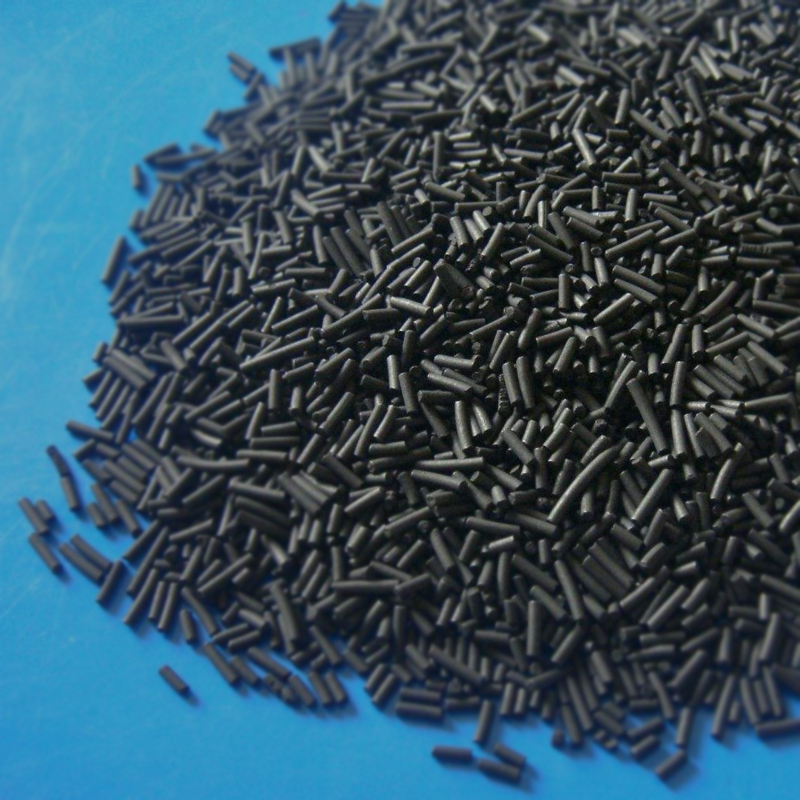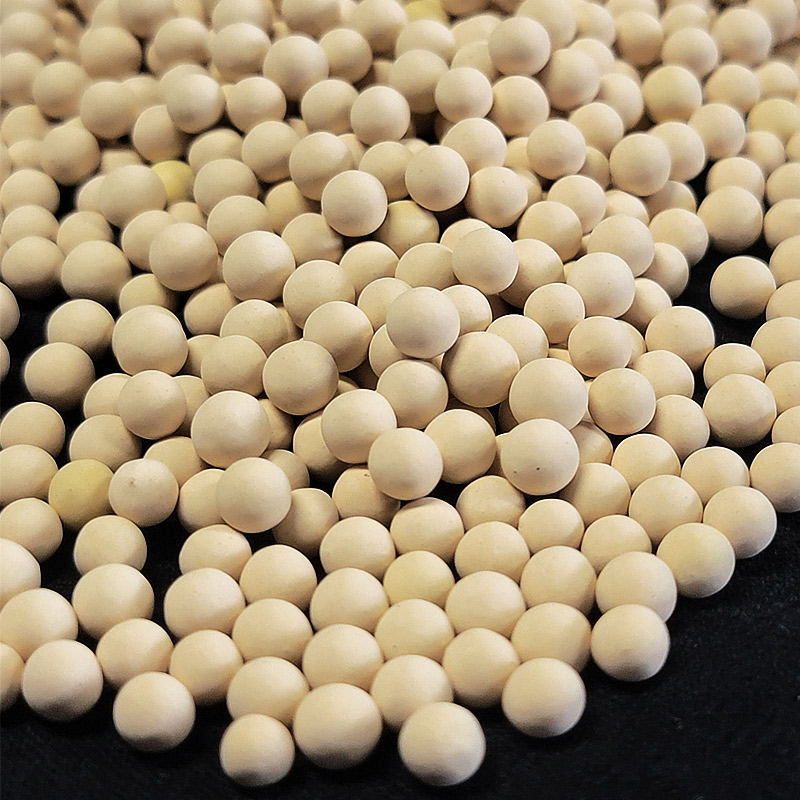Molecular Sieve
-

(CMS) PSA Nitrogen Adsorbent Carbon Molecular Sieve
*Zeolite molecular sieves
*Good price
*Shanghai sea portThe Carbon molecular sieve is a material containing tiny pores of a precise and uniform size that is used as an adsorbent for gases. When the pressure is high enough, the oxygen molecules, which pass through the pores of CMS much faster than the nitrogen molecules, are adsorbed, while the coming out nitrogen molecules will be enriched in gas phase. The enriched oxygen air, adsorbed by the CMS, will be released by reducing the pressure. Then the CMS is regenerated and ready for another cycle of producing nitrogen enriched air.
Physical properties
Diameter of the CMS granule: 1.7-1.8mm
Period of adsorption: 120S
Bulk density: 680-700g/L
Compressive strength: ≥ 95N/ granuleTechnical Parameter
Type
Adsorbent pressure
(Mpa)Nitrogen concentration
(N2%)Nitrogen quantity
(NM3/h.t)N2/Air
(%)CMS-180
0.6
99.9
95
27
99.5
170
38
99
267
43
0.8
99.9
110
26
99.5
200
37
99
290
42
CMS-190
0.6
99.9
110
30
99.5
185
39
99
280
42
0.8
99.9
120
29
99.5
210
37
99
310
40
CMS-200
0.6
99.9
120
32
99.5
200
42
99
300
48
0.8
99.9
130
31
99.5
235
40
99
340
46
CMS-210
0.6
99.9
128
32
99.5
210
42
99
317
48
0.8
99.9
139
31
99.5
243
42
99
357
45
CMS-220
0.6
99.9
135
33
99.5
220
41
99
330
44
0.8
99.9
145
30
99.5
252
41
99
370
47
-

Molecular Sieve Active Powder
Activated Molecular Sieve Powder is dehydrated synthetic powder molecular sieve. With the character of high dispersibility and rapid adsorbability, it is used in some special adsorbability, it is used in some special adsorptive circumstances, such as being formless desiccant, being adsorbent mixed with other materials etc.
It can remove water eliminate bubbles, increase uniformity and strength when being additive or base in paint, resin and some adhesives. It can also be used as desiccant in insulating glass rubber spacer. -

Carbon Molecular Sieve
Purpose: Carbon Molecular sieve is a new adsorbent developed in the 1970s, is an excellent non-polar carbon material, Carbon Molecular Sieves (CMS) used to separate air enrichment nitrogen, using room temperature low pressure nitrogen process, than the traditional deep cold high pressure nitrogen process has less investment costs, High nitrogen production speed and low nitrogen cost. Therefore, it is the engineering industry’s preferred pressure swing adsorption (P.S.A) air separation nitrogen rich adsorbent, this nitrogen is widely used in chemical industry, oil and gas industry, electronics industry, food industry, coal industry, pharmaceutical industry, cable industry, metal heat treatment, transportation and storage and other aspects.
-

Alcohol Dehydration in Distillation Tower/Desiccant/Adsorbent/Hollow glass molecular sieve
Molecular sieve 3A, also known as molecular sieve KA, with an aperture of about 3 angstroms, can be used for drying of gases and liquids as well as the dehydration of hydrocarbons. It’ s also widely used for the complete drying of petrol,cracked gases, ethylene, propylene and natural gases.
The working principle of molecular sieves is mainly related to the pore size of molecular sieves, which are 0.3nm/0.4nm/0.5nm respectively. They can adsorb gas molecules whose molecular diameter is smaller than the pore size. The larger the size of the pore size, the greater the adsorption capacity. The pore size is different, and the things that are filtered and separated are also different. In simple terms, 3a molecular sieve can only adsorb molecules below 0.3nm, 4a molecular sieve, the adsorbed molecules must also be less than 0.4nm, and 5a molecular sieve is the same. When used as a desiccant, a molecular sieve can absorb up to 22% of its own weight in moisture.
-

13X zeolite bulk Chemical Raw Material Product zeolite molecular Sieve
13X molecular sieve is a special product which is produced to meet the special requirements of air separation industry. It further enhances the adsorption capacity for carbon dioxide and water, and also avoids tower frozen during air separation process. It also can be used for oxygen-making
13X type molecular sieve, also known as sodium X type molecular sieve, is an alkali metal aluminosilicate, which has a certain basicity and belongs to a class of solid bases. 3.64A is less than 10A for any molecule.
The pore size of 13X molecular sieve is 10A, and the adsorption is greater than 3.64A and less than 10A. It can be used for catalyst co-carrier, co-adsorption of water and carbon dioxide, co-adsorption of water and hydrogen sulfide gas, mainly used for drying of medicine and air compression system. There are different professional varieties of applications.
-

High Quality Adsorbent Zeolite 5A Molecular Sieve
The aperture of molecular sieve 5A is about 5 angstroms, also called calcium molecular sieve. It can be used in the pressure swing adsorption instruments of oxygen-making and hydrogen-making industries。
The working principle of molecular sieves is mainly related to the pore size of molecular sieves, wThey can adsorb gas molecules whose molecular diameter is smaller than the pore size. The larger the size of the pore size, the greater the adsorption capacity. The pore size is different, and the things that are filtered and separated are also different.When used as a desiccant, a molecular sieve can absorb up to 22% of its own weight in moisture.
-

Desiccant Dryer Dehydration 4A Zeolte Molecular Sieve
Molecular sieve 4A is suitable for the drying of gases(e.g: natural gas, petrol gas) and liquids, with an aperture of about 4 angstroms
The working principle of molecular sieves is mainly related to the pore size of molecular sieves, which are 0.3nm/0.4nm/0.5nm respectively. They can adsorb gas molecules whose molecular diameter is smaller than the pore size. The larger the size of the pore size, the greater the adsorption capacity. The pore size is different, and the things that are filtered and separated are also different. In simple terms, 3a molecular sieve can only adsorb molecules below 0.3nm, 4a molecular sieve, the adsorbed molecules must also be less than 0.4nm, and 5a molecular sieve is the same. When used as a desiccant, a molecular sieve can absorb up to 22% of its own weight in moisture.





